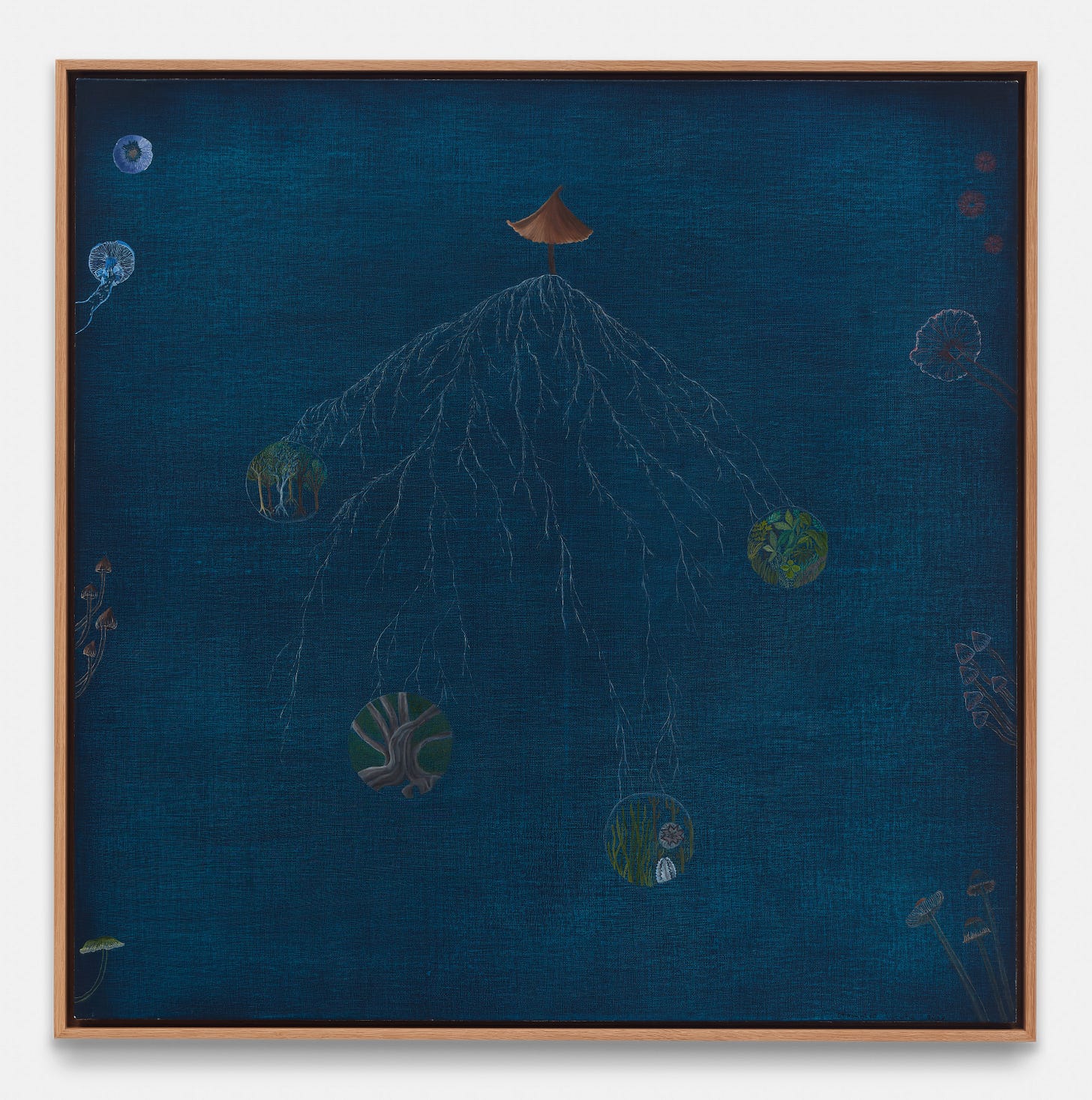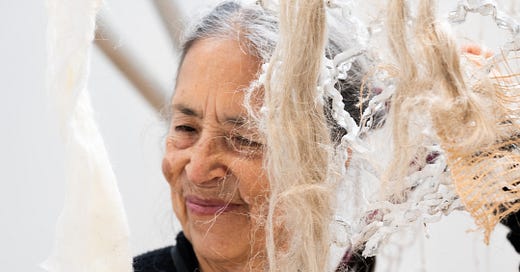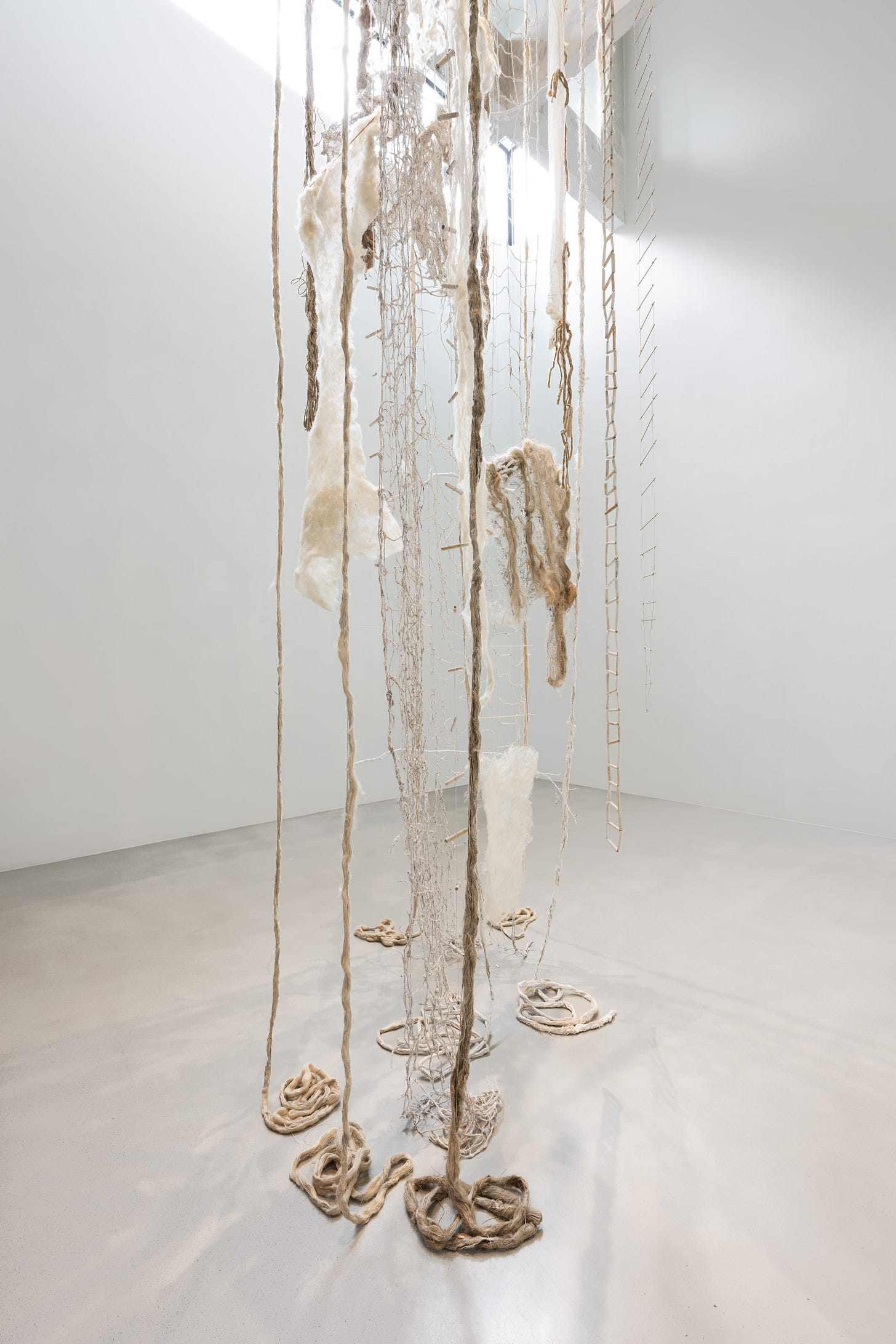A New Psychedelic Mushroom Gets the Artistic Treatment
A recently discovered species of psilocybe from Ecuador sparks questions about art and conservation.
Step into a dark room in Chilean-born artist and poet Cecilia Vicuña’s newest exhibition Arch Future in Brussels and you’ll see a light coming up, ever so slowly, on an oil painting of a psychedelic mushroom.
A small brown fungus with a cap like a pointed witch’s hat sits at the top of the painting against a backdrop of rich blue. Mycelia branch out below and connect it to small depictions of trees and plants in a shape that subtly suggest a human’s silhouette. In the background at the gallery you’ll hear an original song that melds human voices and the sounds of the forest where the mushroom was found.
The painting is called Psylocibyn (stametsii), and it was inspired by the recent discovery of Psilocybe stametsii, a new species of psychedelic mushroom found in the Los Cedros cloud forest of Ecuador. The tiny fungus is named after Paul Stamets, the North American mycologist and mushroom entrepreneur who has inspired a generation of mycology and psychedelics enthusiasts. And it was found on a research trip that included musician Cosmo Sheldrake (brother to Merlin Sheldrake, author of the best-selling fungi book Entangled Life); writer Robert MacFarlane (who recounts the journey in his latest book Is a River Alive?); and Chilean-Italian mycologist Giuliana Furci, among others. Their trip focused on the growing “Rights of Nature” movement, which advocates for the recognition of ecosystems and “more-than-human” species as having inherent legal rights.

Vicuña, the artist, has long entertained a fascination with both psychedelics and conservation. She’s made multiple portraits over the years of María Sabina, the Mazatec woman credited with introducing (however unintentionally) much of the Western world to psychedelic mushrooms. She’s also created art that wrestles with everything from insect extinction to the aesthetics of garbage. If her work doesn’t fit into the tropes of distortion and unreality so often associated with “psychedelic art,” it’s because she’s perpetually looking for her own artistic language to express her experience with psychedelic fungi and plants. “That experience is something so subtle and powerful at the same time that you can’t possibly have a prescribed norm for this representation,” she told me on a video call from her studio in New York.
What is expressed in the painting Psylocibyn (stametsii) and the song, Honguito niño, that accompanies it, is less about the experience of being on psychedelics — after all, no human is known to have used stametsii in that way to date — and more about the experience of encountering it in its home ecosystem. Sheldrake, who composed the music that accompanies the painting, was present when Furci found the mushroom and he stuck a contact microphone into the exact spot where the mushroom was plucked to pick up the sounds reverberating through the soil. Those noises, combined with recordings of the forest, as well as the song that Furci hums while hunting for mushrooms and Vicuña’s own vocalizations, are interwoven into the audio track.
Furci, who co-described and named the new Psilocybe stametsii, and who founded the world’s first fungal conservation nonprofit, the Fungi Foundation, goes way back with Vicuña. They first met in a “psychedelic context” at a women’s retreat over a decade ago, and have remained close since. When Furci shared the story of Psilocybe stametsii, it immediately sparked Vicuña’s artistic imagination.
As Furci tells it, she was walking through Los Cedros when she heard a mushroom “calling out” to her. She had been asked by fellow mycologist Bryn Dentinger at the University of Utah to keep an eye out for the little brown mushroom with a pointy cap that he had collected in the same forest about a decade prior. To officially declare the fungus a new species would require a second finding.
Though Furci was doing her best to remain present while on the expedition, she was also wracked by grief as she walked through the forest; her father had just passed away, and she felt she was living in “the world of the dead.” “I didn’t know if I was able to hear the fungi anymore,” she said.
Furci is one of a number of mushroom hunters who describe having the sense that a certain mushroom is nearby before she’s seen it. Some explain this intuition as arising from a set of environmental clues — shade, moisture, nearby plant life — that the experienced mushroom hunter is processing below the level of consciousness. Others, like Furci, venture into what Potawatomi ethnobotanist Robin Wall Kimmerer describes as the “grammar of animacy,” using language that implies that a mushroom might in fact “call out” to them.
However you explain it, Furci began to feel that the mushroom was nearby while trekking in the forest. “I think she’s here,” she told the group. Sure enough, just a few meters down the trail, Furci spotted a mushroom with what looked like a witch’s hat, smaller than her pinky. She was sure that she’d found the mushroom she was looking for — and after she’d collected it, dried it, and brought it back to the lab for DNA testing, it turned out she was right. She hadn’t lost her ability to hear the mushrooms after all.
Together Furci and Dentinger named the newly-discovered fungus Psilocybe stametsii after Paul Stamets, who has inspired so many — including Furci herself — with his dedication to mushrooms. “If it weren’t for Paul’s books, I probably wouldn’t have been able to be a mycologist,” she told me on the phone. Early in her mycological career, the only books on fungi that Furci could get her hands on in Chile, where she lives, were Stamets books that she had shipped from the US. In the early 2000s, she saved up for a whole year to be able to attend a course with him in the US, where they immediately clicked. “He was the first person I’d ever met that loved mushrooms as much as I did,” she said.
Stamets, who is now on the board of Furci’s foundation, “shed some tears” when he heard about the new mushroom’s name. “Paul had never had a mushroom named after him, any fungus, let alone a Psilocybe,” Furci said.
Though conservation and psychedelics tend to occupy different tracks within the world of mycophiles, Furci believes there’s room for more overlap between the two. “There’s something very powerful about the conviction that comes with the psychedelic experience, where something that might seem like a totally loony idea is legitimized within yourself,” she said — a conviction that can be useful when put to work on behalf of conservation, whether of fungi or other species. And art, she noted, adds another layer, helping to communicate the feeling and urgency that conservation efforts so desperately need.
Psilocybe stametsii has been in the midst of that kind of overlap since before it had a name. In addition to the recordings that became Honguito niño, Sheldrake made recordings in Los Cedros where the mushroom was found that became “Song of the Cedars,” which he and the others used to try and argue for the forest’s co-authorship of the song as part of a larger legal strategy to protect the forest.
Whether or not that effort will be successful remains to be seen, but it’s a testament to the interspecies relationships that will be necessary to save flora, fauna and funga — the very kind of relationships that Vicuña set out to depict in her new work. “Through this quality of relationship between humans and mushrooms, we can really begin a regeneration of life on Earth,” Vicuña said. “That’s what inspired the painting, and that’s what the painting actually says.”
Arch Future is open to the public through August 2, 2025 at Xavier Hufkens Gallery in Brussels, Belgium.
Whitney Bauck is a journalist focused on climate and environmental issues who reports for the Guardian and edits the print magazine Atmos. Find more of her work on Substack, Bluesky, and Instagram.






